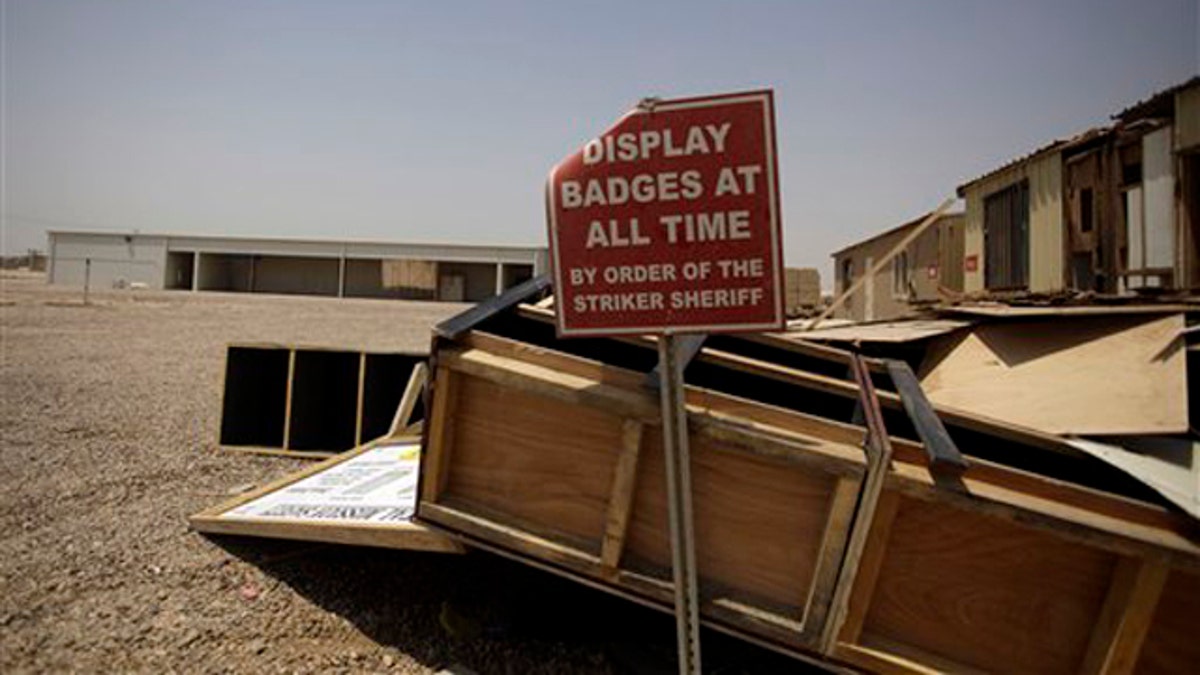
In this Aug. 4 photo, scraps of wood from the post office and a sign remain at a shuttered Camp Sather, part of the sprawling U.S. military Victory Base Complex that is set to close in Baghdad, Iraq. (AP)
The next three months in Iraq will look like a veritable fire sale, as 45,000 U.S. forces prepare to leave by the Dec. 31 deadline.
Rather than ship home valuable military hardware, incurring excessive shipping costs, the Pentagon is simply going to leave millions of pieces of equipment behind, including everything from vehicles and body armor to trailers and air conditioners.
When all is said and done, Pentagon planners estimate 3.47 million pieces of equipment worth $313 million will be handed over to the Iraqi government, which still has not asked U.S. forces to stay beyond the December deadline.
The most valuable equipment -- an estimated 1.5 million items -- was shipped home in the last 12 months. About 800,000 pieces of equipment must be removed from Iraq in the next three months.
Maj. Gen. Jeffrey Buchanan, the top spokesman for U.S. Forces-Iraq, says it wouldn't be cost prohibitive to take these supplies out of the country along with the troops. But there are other considerations.
"It seems to me we really have three choices," Buchanan told Fox News in an interview from Iraq. "We can either leave the equipment to whoever may find it, basically abandon it as we transition the base, or we can pay the millions of dollars it would take to move this equipment back to the United States. ... Or we can maintain complete accountability of it and transfer it to the government of Iraq, who may still be able to get some use out of it."
Buchanan said handing the equipment to the Iraqis is the most responsible route.
Military officials estimate that U.S. taxpayers will save $600 million by leaving this equipment in Iraq. Aside from the equipment, there are still 44,000 U.S. troops in Iraq scheduled to come home by the end of the year.
According to defense officials, this is the biggest logistical operation since the build-up for World War II.
Humvees and mine resistant vehicles, whose V-shape hulls protect troops from roadside blasts, are worth the cost of refurbishing, but trucks and SUVs worth $30,000 when purchased new in 2004 are only worth about $5,000 to $8,000 today and would cost more than that to ship back to the U.S. Looming defense budget cuts make it more cost-effective to leave equipment in Iraq than to bring it home, where budgets face cost-cutting by Congress.
The U.S. military built about 505 bases and outposts at the height of the Iraq War in 2005 and during the surge. About 34 bases remain in U.S. hands, according to Pentagon officials. Those bases cost billions of dollars to build and look as though they were built with the idea that U.S. planes and forces could use them in the future as a long-term basing option. In Balad, a 15-square-mile joint base is home to three dining facilities, several sports fields, a movie theater and the largest airfield in Iraq -- all built with U.S. taxpayer money.
Buchanan said some of the amenities on these large bases, including swimming pools, were already there. "Those bases were in the Iraqi Security Forces before we came. We occupied them. ... I am not going to apologize for ensuring our soldiers can sleep at night when it's 120 degrees outside," he said.
The Obama administration has since decided not to negotiate to position more than a small training force inside Iraq, meaning those heavily modified airstrips and bases will be given to the Iraqis at no cost.
Another example of equipment that the U.S. plans to leave behind is the common jersey barrier, or T-wall as it's known in Iraq. The walls, shaped like an upside-down "T," lined the roads throughout Baghdad at the height of the war and served to protect government and commercial buildings from bombs and other attacks.
Military officials in Iraq say pouring a new T-wall, depending on its size, costs between $800 and $5,000 -- but it would cost $5,000 to ship one home.
Buchanan said it's important to remember the military is not giving away any weapons, humvees, tanks or heavily armored vehicles. For example, the Iraqi Army's 140 M-1 tanks were purchased from the United States. Iraq has paid for 90 percent of its military hardware through foreign military sales with the United States, Buchanan said.
Most of the U.S. weapons systems that are still useful have already been sent to Afghanistan.




